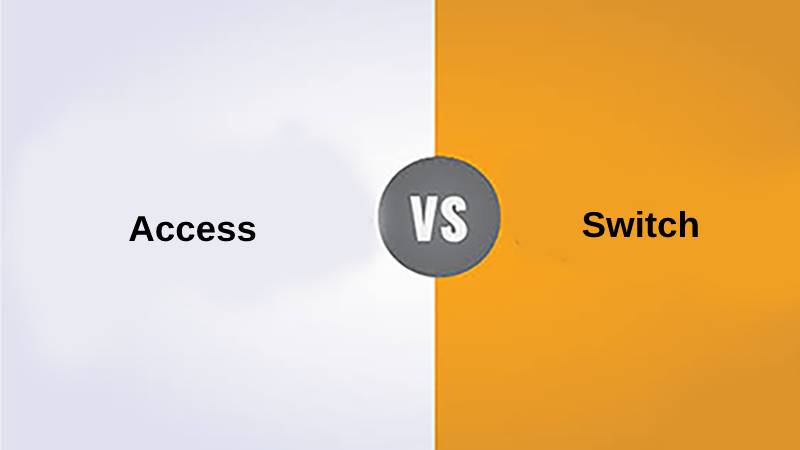Hundreds of gadgets circulate information or data from one location to another in the Internet era. The more simple this technique appears to be, the more complicated the functionality it contains. A person may have several electronic gadgets that must be linked to the internet. An access point or switch is a piece of hardware or software that allows a person to connect to a network.
Access Point vs Switch
An access point connects wireless devices to a wired network, enabling Wi-Fi access. A switch connects multiple devices within a wired network, facilitating data exchange.

An access point is a device that is part of a LAN that is used to extend a computer network’s wireless reach. This can expand the number of people who can access a computer network. The access point device converts a wired signal to a wireless signal and establishes a WiFi connection with other devices in the network. Wireless routers can be utilized as access points on occasion.
Switches are used in big computer networks to connect several computers in a single local area network (LAN). Multiple switches may be necessary to link distinct groups of computer networks, depending on the network size.
Comparison Table Between Access Point and Switch
| Parameters of Comparison | Access Point | Switch |
|---|---|---|
| Function | Connects wireless devices to a wired network, providing Wi-Fi access. | Connects multiple wired devices within a network, enabling data exchange among them. |
| Typical Use Case | Extends Wi-Fi coverage in a network, allowing wireless devices to connect. | Creates a wired network infrastructure, connecting devices like computers, printers, and servers. |
| Data Handling | Handles wireless data transmission and reception. | Manages data traffic between wired devices, directing it to the appropriate destination. |
| Wireless vs Wired | Primarily for wireless communication. | Primarily for wired communication. |
| Physical Ports | May have Ethernet ports to connect to the wired network. | Contains multiple Ethernet ports to accommodate multiple wired devices. |
| Network Segment | Extends an existing wired network to include wireless devices. | Expands the wired network within a single segment or across multiple segments. |
| Traffic Management | Prioritizes wireless traffic for effective Wi-Fi performance. | Manages traffic among wired devices, facilitating data transfer and communication. |
What is Access Point?
An Access Point (AP) is a crucial networking device that enables wireless communication in computer networks. It serves as a bridge between wired local area network (LAN) connections and wireless devices, such as laptops, smartphones, tablets, and IoT devices. The primary purpose of an Access Point is to extend network connectivity, providing these wireless devices with access to the wired LAN or the broader internet.
Key features and functions of an Access Point include:
- Wireless Signal Emission: The AP emits radio signals, creating a Wi-Fi network that wireless devices can connect to.
- SSID and Authentication: Access Points are configured with a Service Set Identifier (SSID), which is the network’s name. Users connect to the desired network by selecting the SSID and entering authentication credentials, such as a password or security key.
- Connection Management: They manage the connections between wireless devices and the network, including assigning IP addresses through DHCP (Dynamic Host Configuration Protocol).
- Data Routing: Access Points route data between wireless clients and the wired LAN, ensuring that information flows seamlessly between devices on both sides.
- Security: They offer security features like encryption (e.g., WPA/WPA2) and access controls to protect the network from unauthorized access.
- Range Extension: APs can be used to extend the coverage area of a wireless network, ensuring that devices can connect from various locations within a building or outdoor space.
Access Points are commonly used in homes, businesses, and public spaces to create Wi-Fi networks, facilitating wireless connectivity for various devices and enabling the mobility and convenience associated with modern computing and communication.
What is Switch?
Switches can recognize the source of information delivered to them and transfer it to the correct destination; switches are quicker and more efficient than hubs. Switches are capable of simultaneously sending and receiving data. Residential networks that exchange music and play network games benefit greatly from switches.
The data connection layer was originally called layer 2 and Layer 3. Multilayer or layer-3 switches deliver and receive data using layer 3. A changeover is long-lasting, lasting between 5 and 10 years. The power required to run a switch device ranges from 14 to 30 watts, depending on the type.
A switch, like an access point, has a MAC address. It contains a lot of ports, which is useful when you need to connect many devices at once. A switch’s operation necessitates the usage of several cables. For network connectivity, the hots of networks rely on switches.
Fiber Channels, Ethernet, ATM, RapidIO, and other networks are supported via switches. Managed switches, unmanaged switches, smart switches, Enterprise managed switches and other devices can all be found on switches.
Main Differences Between Access Point and Switch
- An access point is a wireless device that sends data from one location to another. Switches, on the contrary, are exclusively utilized in wired networks.
- An access point can use somewhere between 6 and 8 watts of electricity. On the contrary, a switch needs between 14 and 30 Watts to operate.
- WAP and AP are additional terminologies used in place of access points. On the other hand, a switch is known as a switching hub and MAC bridging.
- Data is received and delivered via access points, which transform it into 5GHz and 2.4GHz signals, whereas the switch transfers data in packets to its destination.
- Access points receive and send data, converting it to 5GHz and 2.4GHz signals, whereas a switch sends packets of data to its destination.
Conclusion
A computer network is a large expanse containing millions of pieces of data that is extremely difficult to comprehend. It is, nonetheless, one of the most important mediums everyone uses in modern times.
The unique feature of twenty-first-century technology is that it is difficult as usual, yet electronic gadgets have made it accessible to the general public. Switches and access points are two examples. These gadgets are both inexpensive and simple to use.
Users can connect to networks through access points and switches, which is how words like “online pals” came to be. It is also advantageous in the workplace. As a result, acquiring one of them would never be a waste of money.



















